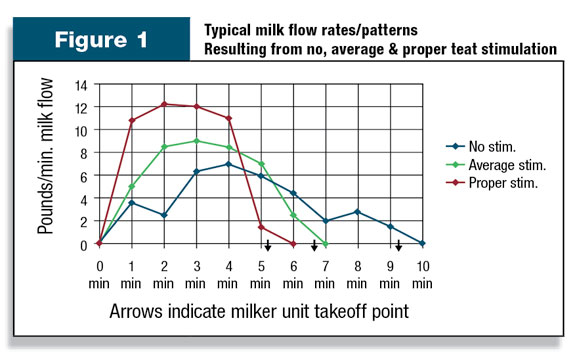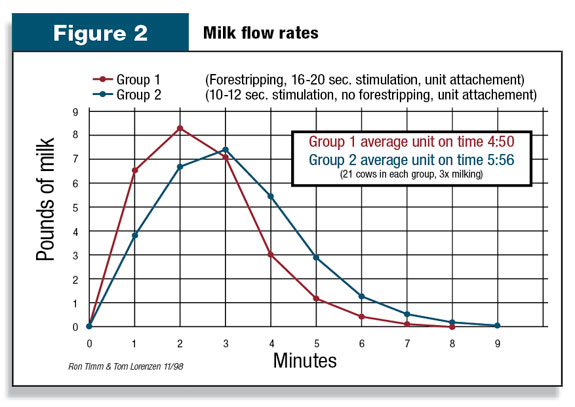Since the beginning of time, calves have been efficiently stimulating and harvesting mother’s milk.
As dairy operations seek to harvest more quality milk from cows in less time, lessons can be found in nature. It comes down to training milkers to mimic the calf.
Physiology of the udder
First let’s examine the basic anatomy and physiology of the udder. Between each milking, milk accumulates in the alveoli, the milk ducts, the gland cistern and the teat cistern.
Most of the milk stored in the milk ducts and cisterns – about 40 percent of the total accumulated – can be removed with very little stimulation. The rest of the milk, stored in the alveoli, can only be harvested when the myoepithelial cells (muscles) contract and force/squeeze the milk out of the alveoli.
The hormone oxytocin, which is stored in the pituitary gland, is what causes the contraction of the myoepithelial muscles. When teat stimulation begins, the nerves are activated, causing the release of oxytocin. What happens next and the timing of it all is important for milkers to understand:
• It takes one to two seconds after the nerves are activated to release the oxytocin.
• It then takes 19 to 22 seconds for the oxytocin to arrive at the receptors in the udder and cause the contraction of the myoepithelial cells.
• The myoepithelial cells contract completely in six seconds.
• It takes 20 to 30 seconds to completely fill the milk ducts and the cisterns. Teats are now flush with milk.
• The oxytocin flow initiated at the beginning of this process lasts for five to six minutes.
For optimal milking, the milking unit should be attached within 20 to 30 seconds after proper stimulation. That’s what a calf does – stimulates milk letdown and then nurses immediately. The entire milking process, from attachment to takeoff, should take place and be completed during the five to six minutes of oxytocin flow.
It’s important to note that more and proper stimulation in the beginning of the milking process is what gets the oxytocin flowing. Increased oxytocin flow increases pressure on the alveoli, where 60 percent of the milk is being stored. Think of it this way:
More and proper stimulation >> more oxytocin >> more contraction of the alveoli >> more pressure >> more milk squeezed out of the alveoli = faster milking
What is ‘proper’ stimulation?
The key to proper stimulation is emulating how a calf approaches a cow, triggers milk letdown, and completes its own milking process – all within an optimal time window for milk flow.
Proper stimulation begins with forestripping, which gets the process going. It’s the equivalent to the calf’s first nudges against the udder. It also gives the milker the opportunity to check for and remove abnormal milk. The next step is teat massage, which, like the calf’s tongue, greatly aids the stimulation process.
Because time is a critical element here, I recommend the use of an effective one-step sanitation method that can both bring the stimulation process to its peak while providing good cleaning of the teat ends. The milker should use a gentle downward circular motion, as a calf does, with focus on the teat ends. This process should continue until milk letdown, at which time the milker should attach the milking unit immediately. Research shows that optimal milk harvest happens with proper stimulation and milking unit attachment within 20 to 30 seconds of stimulation.
Benefits of a good process
The benefits of emulating the calf come in the form of increased milk flow, a boost in milk harvest and decreased milking time. When our technicians visit dairies, we are asked to analyze the milk process from a sanitation and milk quality perspective. In doing so, we often find shortcuts in the stimulation process.
These shortcuts, according to industry research and our own field studies, really aren’t saving milking time at all, and in fact are probably costing the dairy in milk production. Why? Think back to the physiology of the udder – it takes a certain amount of time and the right type of touch for oxytocin to do its job. Once milk is let down, peak milk flow happens during that initial oxytocin flow. Timing is important, as you can see from Figures 1 and 2.

Another benefit of proper stimulation and on-time unit attachment is a reduction in the amount of milk remaining in the udder after milking. Even with excellent milking conditions, the amount of milk remaining in an udder is typically about 12 percent to 15 percent of the total volume of milk before milking. The amount of milk left behind is increased with improper stimulation and late unit attachment.
Other notes on milk letdown
As you evaluate your milking process for efficiencies, alert your milking team to other physiological factors that affect milk letdown. If your prescribed stimulation process isn’t yielding the expected results, one of these factors may come into play:
• Early lactation cows stimulate faster than late-lactation cows. Therefore, later-lactation cows need more stimulation for good milk letdown.

• The receptors in the udder become less sensitive to oxytocin once the cow is pregnant. That’s because hormones (estrogen and progesterone) increase, decreasing the sensitivity of the receptors in the udder.
• Trace mineral deficiencies, such as insufficient cobalt and manganese, can decrease the sensitivity of the receptors in the udder.
• Lack of calcium in the cow’s diet can affect the contraction of the myoepithelial cells (muscles) surrounding the alveoli, causing reduced milk harvest.
Getting what you want – more quality milk faster – means being kind to the cow and treating her as nature designed. That’s why milker training is so important. Make sure milkers know the “natural” techniques behind proper stimulation. Quality milk, maximum milk production per worker-hour and profitability all depend on it. PD

-
Ron Robinson
- Vice President
- Business Development
- A&L Laboratories
- Email Ron Robinson





